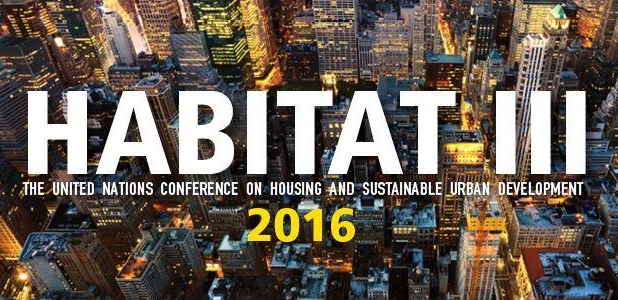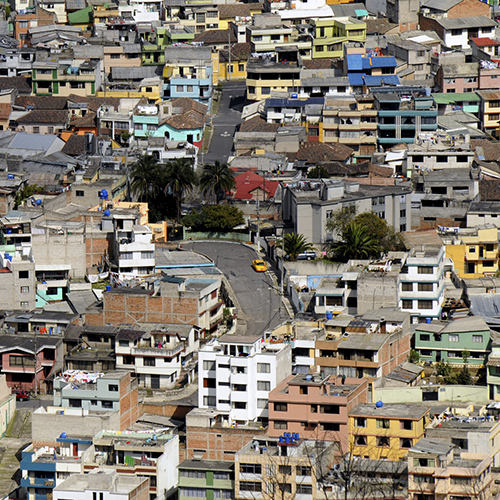 This week the world comes to Ecuador. In Quito, putatively the highest capital city in the world, the United Nations convenes Habitat III, the international gathering that every 20 years sets an urban agenda for the globe. From this great height some of the most powerful institutions will try to figure out some of the more pressing problems the world confronts in decades to come.
This week the world comes to Ecuador. In Quito, putatively the highest capital city in the world, the United Nations convenes Habitat III, the international gathering that every 20 years sets an urban agenda for the globe. From this great height some of the most powerful institutions will try to figure out some of the more pressing problems the world confronts in decades to come.
In Quito the UN will launch a New Urban Agenda through which we might begin to see the world differently. In a world unsure what states are able to do, mistrustful of the decades of market reform, more and more people champion the register of the city as the scale of intervention and organization that might be most suitable for our ‘urban age’. Instead of ‘seeing like a state’ when the nation might be too small to address the major global challenges and too big to generate a common sense of identity, increasingly powerful voices privilege the city as the institutional configuration through which economic development and social reform might be best reconciled.
In the 21st century the journalist and urban commentator Doug Saunders has gone so far as to suggest that “what will be remembered about the twenty-first century, more than anything else except perhaps the effects of a changing climate, is the great, and final, shift of human population out of rural, agricultural life and into cities. We will end this century as a wholly urban species. This movement engages an unprecedented number of people – two or three billion humans, perhaps a third of the world’s population – and will affect almost everyone in tangible ways. ”
In China or India this movement to the city may involve continental distances within a single nation state – from Szechuan to Shanghai or Biharis moving to Mumbai. In the cities of northern Europe mobilities invoke the arrivals of the ‘migration crisis’ from Syria, Afghanistan and the cartography of western military interventions in recent years. But it also involves movements from the European South - Italians, Spanish and Greeks - who may have been nationals of those countries for many generations or are moving on after arriving before the 2008 economic crisis from Latin America or Africa and who have earned the EU passports that confer rights of mobility.
These patterns are complex. Their drivers are multiple and they generate global geometries of ongoing transnational connection between ‘arrival cities’ and the multiple sites of migration origin. At COMPAS we have tried to see such migration as not straightforwardly an academic object to be examined, theorized and problematized. Movements to the city provide a lens through which we make visible key domains of the social, the economic and the political. The city is consequently a useful lens for us to think about the interdisciplinary, the emergent and the combinations of culture and economy, governance and polis, built environment and disruptive technologies.
In Quito the UN-Habitat NUA draft that will structure debates does recognize that migration is an important dynamic in emergent cities globally . Occasionally. But within a humanitarian framing of the social policy challenges of the future migration status becomes more a category of identity politics in the taxonomy of the future city than a driver of socio-material disturbance, cultural change and economic innovation. Perhaps movements to cities across the globe are more significant than this. Perhaps migration can be useful as an analytical tool as well as a demographic to open up the workings of the machine of the city?
Who owns the future? The lens of migration helps us to see differently the cities of the cities of tomorrow. The future city belongs to generations yet to be born, people who are yet to arrive. This is the city of flux, the city that is always changing, always on the move
Migration generates new metropolitan combinations. It brings together old configurations of socio-material systems with new arrivals. These processes of combination refigure the city and redefine the processes of mobility in at least five ways.
- The economic benefits of migration are realized at one spatial scale, the costs at another. Migration benefits the economic welfare of the city as a whole, the concentration of migrants costs the city at a different time and place; at times when schools are oversubscribed, in places where there is pressure on limited supplies of state subsidized housing and waiting lists and doctors’ surgeries in the arrival city neighbourhoods that feel the pressure of immigrant numbers.
- Migration brings strangers to the city. The stranger tends to see the world differently, a disproportionate number of Fortune 500 companies were set up by migrants, newness comes into the world through combinations of old and new. The calculus of benefits and costs of migration needs to recognize how long such innovation dynamics take to impact, the temporalities of the innovations of migrant urbanisms.
- The city works as a ‘revelation machine’. It has the capacity to make some visible, others invisible. In London migrants want to be invisible until the upsides of ethnic identity politics reframe the equation, incentivise a politics of recognition that outweighs the politics of invisibility that valorizes the permeability of the urban system, the ability of new arrivals to find niches in the economic and social landscape that escape the gaze of state power and those that would exclude.
- In UN Policy and urban studies the ‘right to the city’ has become a focus of normative analysis and policy intervention. But this assumes the ability of the city to grant rights, rarely considers the rights of those who have yet to arrive, generations that are yet to be born. Migrant urbanisms make visible the propensity of those who have already arrived to countenance the interests of those arriving. They demonstrate the capacity of the city to accommodate the interests of those not yet present as well as the behaviours of the polis of the present.
- Migration also disrupts the moral calculus through which we measure the ethical rationing of scarce public goods. Do we privilege those who wait longest or those who need most. Both are morally defensible deliberative priorities but the former privileges the ‘resident’ – however poor – the latter privileges the new arrival - however recent. When facing publics of the poor the structures of city governance need to make difficult choices, qualifying claims made in the name of ‘rights’, fashion necessary compromises between such morally incommensurable registers that shape the any emergent urban form accommodates new arrivals.
Migrant urbanisms generate new combinations between material cultures and urban form. They disrupt the homilies about the future city and naively celebratory urbanisms, just as they help us to make visible the interface of policy challenges and ethical dilemmas that will shape the evolution of our shared future.
